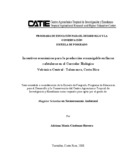| dc.description.abstract | El objetivo principal de este estudio fue determinar los incentivos económicos para la Producción ecoamigable en fincas cafetaleras (n=88) en el Corredor Biológico Volcánica Central - Talamanca (CBVCT), Costa Rica. Los objetivos específicos fueron: 1) Identificar las estrategias de vida de los hogares cafetaleros con base a la dotación de los activos de medios de vida, el contexto de vulnerabilidad y el entorno institucional como determinantes principales para la toma de decisiones, respecto al uso y la conservación de los recursos naturales existentes en las fincas cafetaleras en el CBVCT 2) Determinar la rentabilidad financiera de diferentes formas de Producción cafetalera y 3) Establecer pautas para la creación de un ambiente favorable para el fomento de incentivos económicos para la Producción ecoamigable de café en el CBCVT. Finalmente, otro tipo de incentivo económico que facilitaría la adopción de sistemas ecoamigables de Producción sería un sistema de pagos por servicios ambientales en sistemas Agroforestales que se destacan por la protección de acuíferos, el secuestro de carbono, la conservación de la biodiversidad (ej. conectividad a través de la estructura de sombra) y/o la belleza escénica. Sin embargo, se requiere de estudios comparativos entre diferentes sistemas y sitios en el país, junto con un análisis de potenciales fuentes de financiamiento, para determinar la viabilidad y factibilidad de tal sistema. The main objective of this study was to determine economic incentives for environmentally friendly production in coffee farMON (n=88) within the Central Volcanic Ridge-Talamanca Biological Corridor (CVRTBC), Costa Rica. The specific objectives of this study were: 1) Identify the livelihood strategies of coffee farming households based on their endowment of livelihood assets, the vulnerability context and institutional arrangements as the main determinants for decision-making processes in terMON of the use and conservation of natural resources in the coffee farMON within the CVRTBC 2) Determine the financial profitability of different coffee production systeMON and 3) Establish guidelines for the creation of an enabling environment for the promotion of economic incentives for the production of environmentally friendly coffee within the CVRTBC. Further economic incentives that could facilitate the adoption of environmentally production systeMON are payments for environmental services in agroforestry systeMON for watershed protection, carbon sequestration, biodiversity conservation (e.g., connectivity through diverse structure and composition of shade species) and/or scenic beauty. Nonetheless, it is necessary to conduct comparative studies across diverse production systeMON and on different sites in the country, along with the analysis of potential funding sources, to determine the system’s viability and feasibility. | es_ES |


